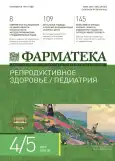Efficacy of pentahydroxyethylnaphthoquinone for the treatment and prevention of retinopathy of prematurity
- Authors: Feoktistova Y.V.1, Poddubniy E.A.1, Tyrtyshnikova A.V.1, Eliseeva E.V.1, Feoktistova E.D.1, Shulgina N.A.1
-
Affiliations:
- Pacific State Medical University
- Issue: Vol 30, No 4/5 (2023)
- Pages: 115-120
- Section: Original articles
- Published: 05.08.2023
- URL: https://journals.eco-vector.com/2073-4034/article/view/568053
- DOI: https://doi.org/10.18565/pharmateca.2023.4-5.115-120
- ID: 568053
Cite item
Abstract
Background. Retinopathy of prematurity (RP) remains one of the causes of bilateral visual impairment in children. The main cause of RP is not only an imbalance of factors regulating angiogenesis, but also oxidative stress.
Objective. Meta-analysis of studies of the pentahydroxyethylnaphthoquinone, which was developed, patented and has a full production cycle in the Russian Federation; evaluation of the effectiveness of its use in premature newborns to prevent the development and progression of retinopathy.
Methods. The effectiveness of pentahydroxyethylnaphthoquinone in premature newborns to prevent the development and progression of retinopathy was evaluated.
Results. A pilot meta-analysis on the use of pentahydroxyethylnaphthoquinone indicates its benefits in preventing the development and progression of retinopathy. The results depend on the methodology and methods of the study, and therefore should be taken with caution. At the same time, the findings correlate with the positive experience of using this drug in the Russian Federation.
Conclusion. The minimum number of studies included in the meta-analysis allows for indicative results. With a large number of studies in different groups of patients, it is possible that different results will be obtained.
Full Text
About the authors
Yu. V. Feoktistova
Pacific State Medical University
Email: evgeny_brain@rambler.ru
ORCID iD: 0000-0003-4070-9842
Russian Federation, Vladivostok
Evgeny A. Poddubniy
Pacific State Medical University
Author for correspondence.
Email: evgeny_brain@rambler.ru
ORCID iD: 0000-0003-0075-303X
SPIN-code: 6109-7743
Cand. Sci. (Med.), Associate Professor, Department of General and Clinical Pharmacology
Russian Federation, VladivostokA. V. Tyrtyshnikova
Pacific State Medical University
Email: evgeny_brain@rambler.ru
ORCID iD: 0000-0002-8947-7803
Russian Federation, Vladivostok
E. V. Eliseeva
Pacific State Medical University
Email: evgeny_brain@rambler.ru
ORCID iD: 0000-0001-6126-1253
Russian Federation, Vladivostok
E. D. Feoktistova
Pacific State Medical University
Email: evgeny_brain@rambler.ru
ORCID iD: 0000-0001-8382-4184
Russian Federation, Vladivostok
N. A. Shulgina
Pacific State Medical University
Email: evgeny_brain@rambler.ru
ORCID iD: 0000-0002-3105-2562
Russian Federation, Vladivostok
References
- Katargina L.A., Chesnoko- va N.B., Beznos O.V., et al. Experimental study of the pathogenesis of retinopathy of prematurity as a promising direction in the search for new drug approaches to its prevention and treatment. Rossiiskii oftal’mologicheskii zhurnal. 2016;9(1):68–72. (In Russ.).
- Osipova N.A. Clinical and experimental study of the pathogenesis of retinopathy of prematurity. Diss. Cand. Med. Science. M., 2016. (In Russ.).
- Savchenko O.A., Pavlinova E.B., Mingairova A.G., et al. Polymorphism of antioxidant enzyme genes as a risk factor for the development of radical-induced damage in premature newborns. Sovremennye problemy nauki i obrazovaniya. 2016;6 (In Russ.).
- Tedeeva N.S., Mel’nikov V.Ya., Dogadova L.P. The use of histochrome in ophthalmology. Tikhookean Med J. 2014;4:17–20. (In Russ.).
- Nikolaeva G.V., Guseva M.R., Beslaneeva M.B. Analysis of the effectiveness of prevention and antioxidant therapy in preterm children. Vestnik oftal’mologii. 2012;6:57–61. (In Russ.).
- Vakhramova N.G., Kavaleva D.A., Ramazanova L.Sh., Pavlova E.A. Experience in the use of the drug «Histochrome» in the prevention and treatment of the active phase of retinopathy of prematurity. Rossiiskii pediatricheskaya oftal’mologiya. 2014;3:39. (In Russ.). doi: 10.17816/rpoj37609.
- Petrova N.I., Rascheskov A.Yu., Bolgova L.P. Khabibullina N.M. The effectiveness of the drug Pentahydroxyethylnaphthoquinone (Histochrome) 0.02% in the active and cicatricial phases of retinopathy of prematurity. Kazanskiy meditsinskiy zhurnal=Kazan Med J. 2012;93(6):978–81. (In Russ.).
- Demchenko E.N., Belyaeva I.A., Katargina L.A. The results of the use of the drug histochrome in children with active retinopathy of prematurity. Rossiiskaya pediatricheskaya oftal’mologiya. 2013;1:15–1. (In Russ.). doi: 10.17816/rpoj37532.
- Omel’yanovsky V.V., Avksent’eva M.V., Sura M.V., et al. Guidelines for conducting a meta-analysis. Approved by order of the Federal State Budgetary Institution «TsEKKMP» of the Ministry of Health of Russia dated December 29, 2017 No181-od. M., 2017. 28 p. (In Russ.).
Supplementary files











